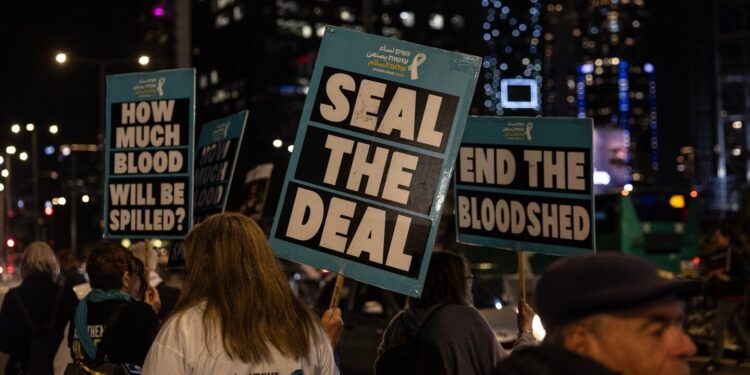The ceasefire deal that Israel and Hamas settled on Wednesday carries nearly the same structure that had been on the table months ago.
This initial arrangement will see the release of several hostages still alive in Gaza, exchanged for Palestinians held in Israeli detention, marking what has been referred to as the “first phase” of the agreement.
A temporary halt to the fighting will last for a few weeks, during which both sides are expected to work toward a follow-up round of exchanges and possibly reach a longer period of calm.

Past Efforts Blocked Repeatedly
Since the war in Gaza started 15 months ago, similar ceasefire discussions have come up many times, especially within the last eight months. But every time the parties got close to an agreement, the deal fell apart at the final stage, and both sides pointed fingers.
Secretary of State Antony Blinken has claimed repeatedly that Hamas backed out of earlier ceasefire efforts. At the same time, Arab mediators and U.S. officials in private conversations blamed Israeli Prime Minister Benjamin Netanyahu for delaying progress by introducing extra demands that Hamas would not accept. Many believe Netanyahu kept the war going to satisfy far-right members of his coalition, whose support keeps him in office.
Although there were still unresolved issues earlier this week, officials on both sides remained quietly confident that a deal could be reached. Majed al-Ansari, adviser to Qatar’s prime minister and spokesman for its foreign ministry, said at a press briefing on Tuesday that they had managed to work through the major disagreements and were close to finalizing the deal.
US Pressed Forward Before Transition of Power
During its final days in office, the Biden administration made a strong push to seal this agreement, working alongside the incoming transition team of President-elect Donald Trump. Trump’s envoy to the Middle East, Steve Witkoff, traveled between Israel and Qatar, where most of the negotiations were being held.
Before the final terms were confirmed, these were the parts that were already known:
The opening stage would involve the release of 33 hostages over 42 days which no fighting would take place. These individuals would be exchanged for Palestinian prisoners, according to information shared by U.S. officials.
An Israeli government official, who spoke without revealing their identity, said that the hostages freed during the first part of the deal would mostly include women, children, elderly individuals, and those who were injured.
After that, a second round of negotiations would aim to free the rest of the hostages still held by Hamas, including Israeli soldiers. According to The Washington Post’s data, around 60 hostages were still believed to be alive inside Gaza.
Israel has also agreed to let hundreds of thousands of Palestinian civilians who escaped bombing in southern Gaza return to their homes in the north, as long as certain safety conditions are put in place.
Many observers credit the deal’s completion to Trump’s upcoming return to the White House. Reports in Israeli media said that Witkoff’s direct and confrontational methods forced Netanyahu to back away from some of his earlier positions.
Political Motives and Domestic Pressure
Last year, as campaign season picked up in the United States, political analysts suspected that Netanyahu preferred dealing with a Republican president. Netanyahu made it clear to officials in the Biden administration that his decisions were limited by political demands at home.
His far-right coalition partners had expressed strong opposition to any prisoner swap and favored a more aggressive military campaign in Gaza.
On Tuesday, Israel’s national security minister, Itamar Ben Gvir, a leading voice from the far-right, claimed responsibility for blocking earlier ceasefire efforts by threatening to resign from Netanyahu’s government.
At this point, Netanyahu appears to be ready to go against Ben Gvir and others in his bloc. What has really changed is the timing on the U.S. political calendar.
Alon Pinkas wrote in the Israeli newspaper Haaretz that by May 2024, Netanyahu had abandoned a plan he had earlier submitted to President Biden.
The exact deal now being implemented was already introduced several times by the United States and Qatar over the last eight months. Pinkas argued that Netanyahu prioritized his political survival and Trump’s re-election over ending the fighting and saving lives.
Israeli Citizens Speak Out Against Delays
Throughout 2024, Netanyahu has faced growing backlash from Israelis, especially from those related to hostages still being held in Gaza. Many of them joined regular protests against his government’s refusal to move forward with a deal.
While the Biden administration spoke often about wanting a ceasefire, they did not use their full influence to pressure Israel into finalizing one. During that period, hostages continued to lose their lives, and Israeli airstrikes killed thousands of Palestinians, worsening the humanitarian crisis in Gaza.
Ben Caspit, writing in the Israeli outlet Ma’ariv, said that Trump convinced Netanyahu to accept the very same proposal that had been introduced months earlier. He urged people not to blame Hamas for the delay.
Caspit pointed out that the militant group had shown readiness to go ahead with this arrangement back in August if they were offered what is now being granted. He stated clearly that the problem came from Israel’s leadership, not Hamas.

Doubts Over Long-Term Peace
Even if this ceasefire takes place, many observers are unsure whether it will lead to anything lasting. Michael Hanna, a program director at the International Crisis Group, said that there is general doubt about whether both parties will go beyond this initial stage of the deal.
Israel’s current government, led by right-wing parties, is unlikely to give Hamas more ground. On the other hand, Hamas may want to hold on to the bargaining chips it still has, including the remaining hostages.
The incoming Trump administration also may not be interested in investing energy into any kind of long-term plan for rebuilding Gaza or supporting Palestinian national goals such as equal rights or statehood.
Hanna added that no part of Trump’s strategy so far has shown a desire to address Gaza’s political future or help shape how it will be governed.
Families Wait and Suffer as Bombing Continues
The uncertainty continues to bring sorrow to both Israelis and Palestinians. Eli Bibas, whose relatives are among the remaining hostages, expressed his pain in a statement.
He wondered aloud how his infant grandson, kidnapped at only eight months old, could be turning two without ever having celebrated a birthday at home with his father and family.
Meanwhile, Israeli airstrikes continued Tuesday, claiming the lives of dozens more. Abeer Maher, a 36-year-old English teacher from Deir al-Balah, said people were terrified of what might happen as the final hours before the ceasefire ticked away.
She told The Post that she and her neighbors had not slept the whole night. She prayed for protection and hoped things would not spiral further as the deal moved closer to becoming real.






















